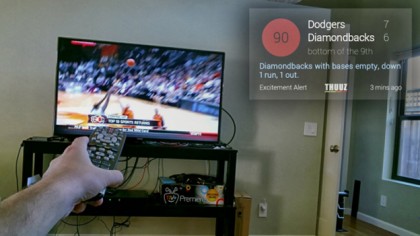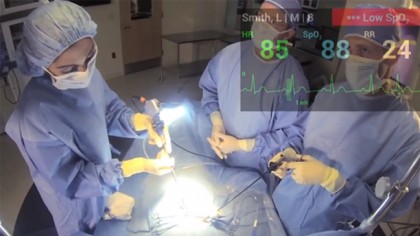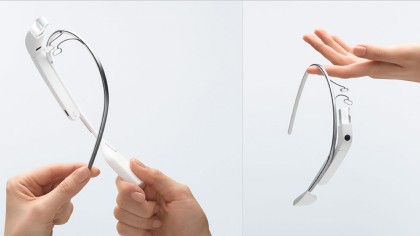2020 vision: The future of Google Glass
Tech soothsayers, AR experts and Glass Explorers share their prophecies
On July 4 2013, PR professional Chris Barrett became the first Google Glass Explorer to create a piece of citizen journalism. In doing so, he also created a few headlines and deeper conversations. Barrett was on the Jersey Shore using Glass to film "a bunch of drunk people" when, unsurprisingly, a fight broke out.
"I guess I kept filming when the cops come out and started arresting people," Barrett, who founded PRServe, told us. "People started pulling their cellphones out, but I just had to look. It was a scary situation, their bloody faces were a couple of feet in front of me, but I didn't have to worry about a cellphone in my hand if I needed to protect myself."
"I looked back at the footage and it felt like a movie rather than a real event. I realised this might be a landmark moment for Glass. "
Barrett uploaded the event to YouTube and started pushing it to media outlets, who prophesized a future of eyewitness accounts that can be instantly uploaded or streamed to our TVs, mobiles and web browsers. Like Twitter, but for news video.

The endgame here is likely to result in a host of apps from news organizations keen for Glass wearers around the world to beam footage directly to them, essentially giving them willing reporters and camera crews all around the world, bringing round the clock eyewitness accounts from breaking news.
"By around 2020, when people start wearing Glass more widely, the battery will last longer, quality of video will improve as will storage (now it holds about 6 hours, but battery is consumed quickly). You're going to be able to walk around the streets, walk around your house, walk around your office recording everything."
The end of privacy
While this could propel us into a new era of citizen journalism, it also raises more questions than it does answers. Privacy and security fears are rife. Could Glass lead to an overhaul of public etiquette? Could it result in less freedom of expression through fear of recrimination or shaming?
Get daily insight, inspiration and deals in your inbox
Sign up for breaking news, reviews, opinion, top tech deals, and more.
"As long as you're in public, you just have to watch your behaviour and not do anything that you wouldn't want to be seen doing on video."
It's probably not that simple.
Barrett himself admits folks who don't want to engage in conversation while he's wearing his Google Glass Explorer Edition have repeatedly shunned him. The threat of boycotts and backlashes, through public trepidation seem certain to arise.
"I think privacy is of course a huge concern. There was a huge stigma associated with just wearing a Bluetooth device! I think they've got a really big challenge ahead of them," Mike Cohen of TI chimes in.
Others would prefer this functionality not to be accepted at all and Google has a job on its hands to change the perception if Glass is to be mass adopted by a wary post-Snowden public
"I think it's a really big problem and I actually hope we don't get to the point where we just accept it as part of everyday life. I don't want to be filmed all the way through my day, I don't want every single thing I do to be recorded forever in a searchable database that anyone can go through and discover every embarrassing thing I've ever done or said forever more. I don't want that for professional reasons and I don't want it for social reasons," said futurologist Ian Person.
All the football, all the time
We've spent a lot of time thinking how Google Glass could change the world, reinvent journalism, save lives, improve our kids' education and immerse us in a fully augmented world, but what about the important stuff, like improving our ability to watch sport 24/7
Thuuz, an app for iOS and Android, which seeks to alert fans to exciting, on-going games, allowing them to tune in either through television or mobile streaming. For example if a Grand Slam tennis final goes to a fifth set or an FA Cup semi-final goes to extra time or penalties, you'll be pinged. The idea is that you'll never miss anything worth seeing.
The California-based company is already in the Glass ecosystem with a scaled-back version of its Android and iOS app, but imagine a world where exciting sporting events could be instantly beamed to your retinas through a device like Glass, while you're out and about shopping or running errands with the family? That's an eventuality Thuuz CEO Warren Packard is working towards.
"I think what we'll really see is societies need for instant gratification come to sports through devices like Glass," he told us. You'll are able to call up games at different times because it fits your profile, and we need to be in the middle of that."

Why will this take until 2020, you ask? Surely the tech is there now? Well the broadcast world tends to drag its feet over embracing new media forms and many of these billion dollar contracts still have years to run.
How about how AR specs could enhance the experience of attending sporting events? Microsoft has filed a patent for its iteration of the tech, which would offer statistical information, player details and more from within the field of vision.
Changing the form
We've already heard how these truly immersive AR experiences aren't necessarily possible until Google Glass becomes more than just a heads-up display that appears in a small portion of the user's vision. So what other forms could we see the tech take by the end of the decade?
"I do think it'll become mainstream," says Thuuz's Warren Packard. "However, I think it'll look different to how it does now. It'll be something that augments many of the different things that we do, whether it's in front of your eye, or attached to a pair of glasses or whether its something that's on your wrist. I think it's inevitable that this won't maintain a form factor of a phone that fits in our pocket or a glass that sits in front of eyes, it's going to proliferate in many different ways and become part of our every day world."
Accenture's Brent Blum, who worked on the Philips Medical concept app for Glass, agrees case-specific realisations of wearable displays are the way forward. "I think Glass specifically is designed to make it appeals to Google's vision of consumer usage.
It's made to be lightweight, comfortable to wear for extended periods of time, the battery and the software itself are optimised. It's not on continually, its supposed to give you information when you need it then get out of the way" he said.

"However, If you think of a surgery scenario where you have a fully immersive display, you can actually see where to place the incision. With Glass, you see a picture of where to place the incision."
As a result of these enterprise needs, by 2020, we could see Glass-like tech be built into safety goggles for engineers or those working in gas and oil. That way, Blum says, pertinent, task specific information could be displayed. Those glasses would also likely contain sensors that would monitor air quality, scout for gas leaks. etc.
Those gaming and learning experiences, mentioned earlier, would also be enhanced by greater coverage of the peripheral vision, perhaps through visors rather than regular specs.
However, we can't discuss the future of head mounted displays without mentioning the possibility they may become eye-mounted displays. Effectively, Google Glass would become Google Contact. That means total retina immersion.
There are plenty of companies looking into this. Belgian microelectronics company IMEC is investigating the feasibility of wearable displays within contact lenses and has already developed a lens that incorporates a curved LCD screen.
Indeed, one futurologist is convinced there is an entirely plausible way create a workable contact lens-based display, have it up and running in the next couple of years, and certainly embedded within consumer-available technology by 2020.
Ian Pearson, author of the new book Total Sustainability, thinks the way to do it is to, in essence, create a micro-projector in the user's eye. "By using a contact lens containing three surface emitting lasers on the periphery and a central micro-mirror that raster scans the laser beams directly onto the retina, a high resolution image is created on the retina, using just a few components to create a high res image makes the lens far better, easier to fabricate and probably cheaper than the one LED per pixel approach proposed in the Google Glass, which will look at best quaintly primitive by the time it comes to market."

However, the challenges here are fairly obvious. Where does the battery go, the antennas, the computing power the camera for recognising objects, all of which sit naturally within Google Glass? How do you prevent the lens getting really, really hot?
They're questions yet to be solved with logical answers. While it's possible that Google Glass will eventually meet its doom at the hands of a lens-based solution, it's seems a longshot it'll be around by the end of the decade.
"In terms of Augmented Reality contact lenses, my understanding of that technology is that we're really, really far away," Blum commented. "By 2020 we might have some prototypes, but that's it. I think there are a lot of challenges around the distances that the eye focuses at, how to power them, etc. I'd still say it's the stuff of science fiction movies."
But wasn't Google Glass itself the stuff of science fiction movies just a few years ago?
- 1
- 2
Current page: 2020 Vision: sports, journalism and privacy
Prev Page 2020 Vision: augmenting reality in the futureA technology journalist, writer and videographer of many magazines and websites including T3, Gadget Magazine and TechRadar.com. He specializes in applications for smartphones, tablets and handheld devices, with bylines also at The Guardian, WIRED, Trusted Reviews and Wareable. Chris is also the podcast host for The Liverpool Way. As well as tech and football, Chris is a pop-punk fan and enjoys the art of wrasslin'.
